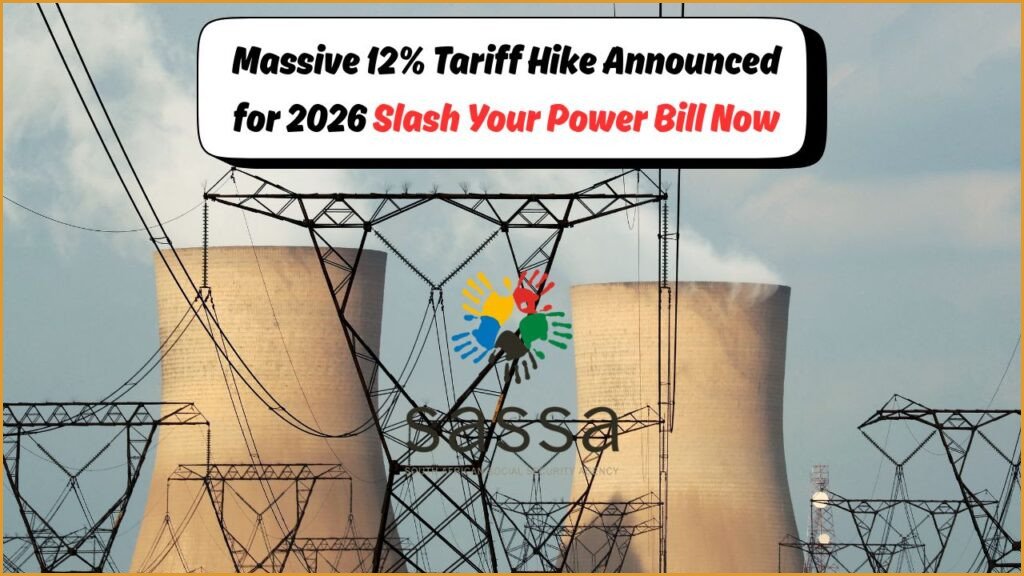12% Electricity Tariff Surge in 2026: South Africans are bracing for a significant increase in electricity tariffs, expected to rise by 12% in 2026. This anticipated hike is prompting households and businesses alike to explore ways to mitigate the financial impact. With energy costs already a substantial portion of monthly expenses, the impending surge underscores the need for strategic planning and proactive measures. As electricity remains a crucial utility, understanding how to manage and potentially reduce these costs is more important than ever. In this article, we’ll explore practical strategies to help you navigate this upcoming financial challenge.

Understanding the 12% Electricity Tariff Surge and Its Implications
The looming increase in electricity tariffs expected in 2026 is a concern for many South Africans. A 12% rise means that households will need to allocate a larger portion of their budget to cover energy bills. This escalation is attributed to a variety of factors, including inflation, increased operational costs, and infrastructure investments by energy providers. Understanding the reasons behind this rise can help consumers prepare and adapt accordingly.
For many, this increase might seem daunting, especially as it follows a series of previous increments in recent years. However, it also presents an opportunity to reassess energy consumption habits. By becoming more conscious of how electricity is used, consumers can identify areas where savings can be made. For instance, simple actions such as turning off lights when not in use, investing in energy-efficient appliances, and utilizing natural light during the day can contribute to reducing electricity consumption. Additionally, understanding your electricity bill and knowing which appliances consume the most energy can guide more informed decisions about usage and potential upgrades.
Effective Strategies to Cut Costs Amidst Rising Tariffs
As the 12% electricity tariff surge approaches, implementing effective strategies to reduce electricity usage becomes paramount. One viable approach is conducting an energy audit to identify inefficiencies within your home or business. An audit can reveal hidden energy drains, allowing you to take targeted actions that will have the most significant impact on reducing your consumption.
Another strategy is to invest in renewable energy sources, such as solar panels. While the initial investment might seem substantial, the long-term savings and potential government incentives can make it a worthwhile endeavor. Solar energy not only reduces dependence on traditional energy sources but also offers the potential to sell excess power back to the grid, further offsetting costs. Additionally, adopting smart technologies like programmable thermostats and energy-efficient lighting can contribute significantly to reducing electricity bills over time.
Adapting Lifestyle Habits to Mitigate Rising Electricity Costs
Adjusting lifestyle habits can play a crucial role in managing electricity expenses in light of the upcoming tariff increase. Simple changes, such as unplugging devices when they are not in use and limiting the use of high-energy appliances during peak hours, can lead to noticeable savings. Encouraging family members or employees to be mindful of their energy usage also fosters a culture of conservation.
Moreover, exploring flexible payment options offered by electricity providers can help manage monthly expenses more effectively. Some providers offer fixed-rate plans or budget billing, which can provide predictability in monthly bills and help avoid seasonal spikes in energy costs. Engaging with community programs aimed at reducing energy consumption or participating in local workshops on energy efficiency can also provide valuable insights and support.
Long-Term Benefits of Energy Efficiency Investments
While the immediate focus may be on managing the 12% tariff increase, it’s essential to recognize the long-term benefits of energy efficiency investments. Upgrading to energy-efficient appliances and incorporating renewable energy solutions can significantly reduce electricity bills over time, providing financial relief beyond the immediate concern of rising tariffs.
Energy-efficient homes not only offer cost savings but also enhance comfort and increase property value. As South Africa continues to prioritize sustainable energy practices, properties with energy-efficient features may become more attractive to buyers, offering a competitive edge in the real estate market. Additionally, reducing energy consumption contributes to environmental sustainability, aligning with global efforts to combat climate change.
Ultimately, while the 2026 electricity tariff surge presents a challenge, it also offers an opportunity for positive change. By embracing energy efficiency and sustainable practices, consumers can mitigate the impact of rising costs and contribute to a more sustainable future.
What are effective strategies to reduce electricity expenses amid rising tariffs?
Implement energy-efficient practices and invest in renewable energy sources.
How can consumers prepare for the anticipated 12% electricity tariff increase?
Implement energy-saving practices and explore alternative power sources.









